The stab fix is already in, the others I don't know. Send it in #suggestions in the discord!

[MOD] Imperator Invictus
- Thread starter Snowlet
- Start date
-
We have updated our Community Code of Conduct. Please read through the new rules for the forum that are an integral part of Paradox Interactive’s User Agreement.
You are using an out of date browser. It may not display this or other websites correctly.
You should upgrade or use an alternative browser.
You should upgrade or use an alternative browser.
Threadmarks
View all 88 threadmarks
Reader mode
Reader mode
Recent threadmarks
DD77: Venetian missions DD78: Getia DD79: Albania and the Hurrians DD80: Caucasian rework, Gordyene tree and Nexusmods DD81: the converter, Yaudheya, Tartessia and the Western Greeks DD82: Raetia, Messapia and Kolchis missions DD83: 1.7 Vesuvius release + Etruria, Samnium, Umbria and 3 other missions DD84: Ides of March update, Spartan colony, Fugandulu and Albion treeWe're currently exploring this option. We would want base trade routes to be impactful enough to be meaningful for small nations, but not sideline noble pop output. We also want the percentage to also be there, but not so much that large cities get a ludicrous amount either.Another thing also regarding the ports and markets, I feel the %trade routes modifier is rather bland. Could they not contribute base trade routes number like nobles do? Say a market gave 0.2 trade routes combined with 6 nobles giving .15 trade routes each would give 1.1 trade routes.
As even if the 6 nobles gave 0.9 trade routes the 7.5% still doesn’t grant a trade route (0.967 trade routes). This only helps large nations who have huge cities and large populations, whereas a small city will suffer. Building a market with a value of 0.2 trade route would be a very good investment earlier in the game for a small city with 6 nobles then instead of having 7.5%, and larger nations wouldn’t have an advantage of multiplying that percentage on larger populations.
It's a very fine line but we may head this direction depending on how testing goes.
- 1
Wouldn’t be more accurate to substitute loyalty bonus from Gran Theatre and Great Temple with respectively a religious happiness and cultural happiness bonus?
- 1
the buildings have both, from vanilla.Wouldn’t be more accurate to substitute loyalty bonus from Gran Theatre and Great Temple with respectively a religious happiness and cultural happiness bonus?
I do agree that buildings should have local happiness effect but not provincial loyalty.Wouldn’t be more accurate to substitute loyalty bonus from Gran Theatre and Great Temple with respectively a religious happiness and cultural happiness bonus?
What has a building in one city to do with provincial loyalty? On the contrary, making POPs convert and assimilate in that city could make the rest of the province more wary of your intentions.
Happiness effect is local and for the targeted group. Provincial loyalty feels wrong and redundant, as happiness is necessary to avoid unrest that makes provinces unloyal.
- 1
Also why would people feel more loyal towards you if there is a theatre or a temple in a city in another territory of the same province?I do agree that buildings should have local happiness effect but not provincial loyalty.
What has a building in one city to do with provincial loyalty? On the contrary, making POPs convert and assimilate in that city could make the rest of the province more wary of your intentions.
Happiness effect is local and for the targeted group. Provincial loyalty feels wrong and redundant, as happiness is necessary to avoid unrest that makes provinces unloyal.
At most they would feel jelous and so less loyal lol
I think this was made purely to justify the cost of those buildings.
- 1
Is there any possibility of a "Christianity mod"?
I recently hoped to have a long campaign, so that later I could convert to ck3 and, when released, to vic3, however, all the mods that added christianity are outdated, and it doesn't seem there are any options.
I recently hoped to have a long campaign, so that later I could convert to ck3 and, when released, to vic3, however, all the mods that added christianity are outdated, and it doesn't seem there are any options.
- 3
DD14: Germania rework
Dev Diary 14: Germania rework
Today we’ll be talking about Germania!
An often requested feature for Invictus is to fill the area around the Rhine with playable tags and add more flavour to Germania. In this Dev Diary, we are going to present you this as well as flavour for these newly added Germanics and the Suebi.
Hello, I am Palando, the main developer for Germania. I am thankfully every now and then supported by @olivenkranz for the flavour texts. Apart from what I am going to present today, there is more content for other parts of Germania Magna planned but not yet ready to show.
------ Rhine-Weser Germanics ------
The primary focus of the Germania rework were the tribes east of the Rhenus (Rhine). Roman writers handed us down a remarkably detailed ‘setup’ for this area, together with some changes that happened during their control of the western side of the Rhine. Among these is the defeat of the Bructeri by the hands of the Chamavi and Angrivari, the migration of the Usipetes and Tencteri during Caesar’s Gallic War, the split of the Batavians and Chattians some unknown time before and the Chattians filling the void left by the Ubians after the latter’s resettlement across the Rhine. It was a goal to ‘reverse’ these movements to come close to the year 304 BC, but we cannot for sure know what happened in this prehistoric time, though archaeology points towards no major migrations for the period preceding the Roman conquest of Gaul.
Talking of which, the Rhine-Weser area was an extremely diverse one archaeologically. Some of the constants, together with the quite sparse written accounts, are going to make their way into the game via missions and events.
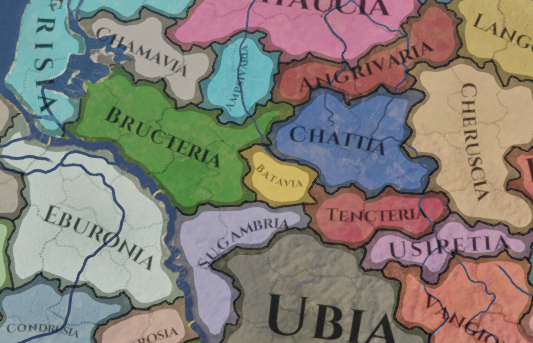
At first, there will be only one unique tree available with the primary path leading to the formation of the Frankish Kingdom. It asks you to unite your area, ‘civilise’ and fight a common enemy. The tasks are modeled around the historical formation of the Franks, albeit that happened later in opposition to the frontier of the Roman Empire. Because Rome’s rise is not certain, you can either wage war with the Romans or a Gaulish neighbour.
The optional branch is mostly based on the archaeological record and demands to build mines, trade with your neighbours, build a fortified trade post (based on the ‘Schnippenburg’) and then finally impose a standard for your iron bars, granting you a permanent bonus.
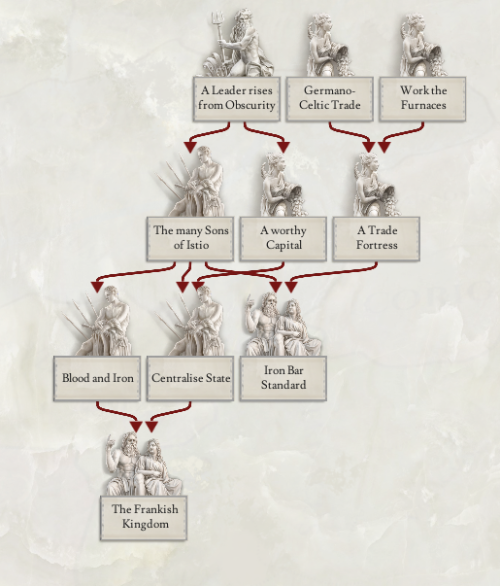
After forming Francia, another tree is unlocked and is based on the early expansion of the Franks. There are several economic and conquest related missions until the final row is reached. Completing the mission tree requires the player to choose which side of the Franks will dominate and set the focus of their country: either the Salians or, like in history, the Ripuarians.

------ Extremely Important Eburones -----
Across the Rhine, the cisrhenic Germanics were also looked upon. The biggest of those were the Eburones, which received the land they had according to Caesar and modern scholars. Additionally, four other smaller cisrhenic tribes were added: Paemania, Segnia, Caerosia and Condrusia.
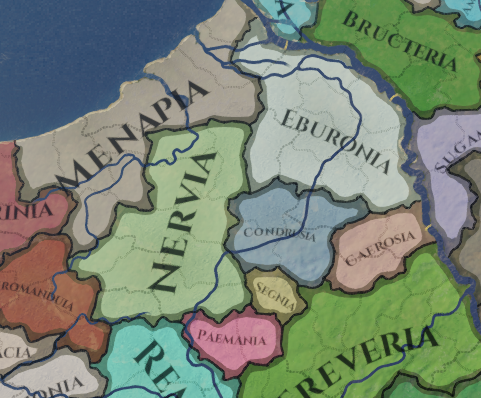
Aduatucia was removed, as Caesar mentioned their creation by some Cimbric migrants during the migration of the Cimbri, Teutones and Ambrones. Also, Cugernia was removed, as they were created, when the Romans resettled a few Sugambrians.
We have plans to add more content to the Belgae, but they are not ready yet to be publicly shown.
------ Celts of Central Germany ------
Life was quite simple in ancient ethnography: west of the Rhine Celts with the exception of the cisrhenic Germanics and east of the Rhine only Germanic tribes. Archaeology paints here a somewhat different picture, as central and southern Germany was part of the La Tène culture, which is nowadays equaled to Celts by most scholars.
By the time the Romans reached the Rhine, most of the Celts of those areas had already moved to Gaul or were in the process to do so. Among these were the Helvetii, which left behind the so-called Helvetian desert in south-western Germany. But it appears that the Suebian leader Ariovistus also had Celtic allies in his federation, although Casar identified them all as Germanics. This can be deduced from the Celtic tribal names of the Nemetes and Tribocci, or the material culture and other names for the Vangiones, although the latter had a Germanic tribal name. The Suebi also threatened the Ubii, who can be identified as the inhabitants of one Celtic oppidum (= city) based on archaeology.
In sum, those four tribes were placed in the void between the Helvetii in the south and the Germanic north. Apart from the Ubii, however, there is some uncertainty as to from where the Vangiones, Nemetes and Tribocci originally came. The land those three own in the current setup was distributed between the Rauraci and Mediomatrici (note: these three inhabited Alsace only after Ariovistus crossed the river Rhine).

----- Suebi -----
As mentioned in the previous paragraphs, the Suebi started pushing westwards and crossed the Rhine. A welcome justification for Caesar to wage war against them. Although Caesar won, the Suebi still permanently filled the void left by the Celts that left central Germany and the Bohemian basin. The Marcomanni in Bohemia, the Quadi in Slovakia and Hermunduri in central Germany would threaten the Roman Empire in the 2nd century AD from those positions they already acquired in the second half of the 1st century BC.
The three aforementioned tribes were also added to the setup (respectively repositioned in the case of the Marcomanni):
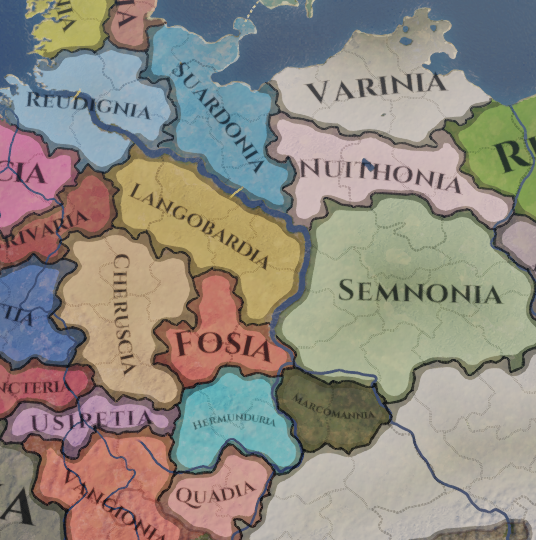
Suardonia and Nuithonia are additions of Invictus’s release version.
Suebi nations also receive unique flavour like a decision to embellish their famous grave fields, the biggest of those was Mühlen-Eichsen close to the Baltic coast. Primarily, the mission trees are based on the settling of the Bohemian basin and the fight between Ariovistus and Caesar.
After forming Suebia or alternatively by starting as Marcomannia or Quadia, the player gets access to a mission tree to bring the Celtic reign in Boihaemia to an end. This new home has then to be settled and defended against foes from the south. An optional task is to enslave the Cotini living in the Slovakian mountains, as they were known to the Romans as tributaries that delivered gold to their Suebian overlords.
Historically, the timeline and events are not completely clear, but according to archaeology the intrusion of the Suebi into Bohemia started already when Caesar campaigned in Gaul. So unlike most of the interpretations of Roman sources, it appears that Maroboduus was not the conqueror and destroyer of the Boii.
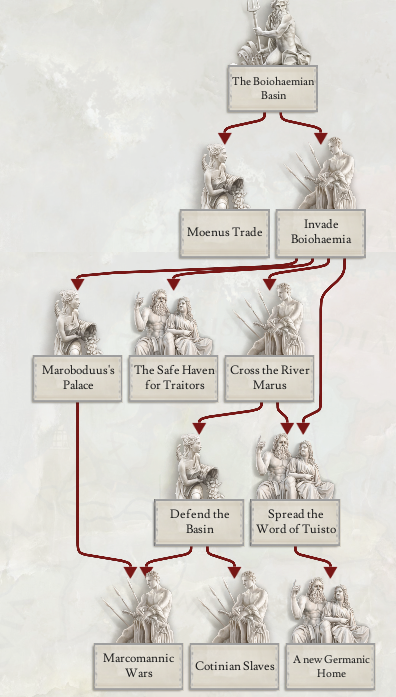
The Cotini were also added as a two province minor in the Slovakian mountains. They start with access to gold, but it is up to the player how she or he will grow their domain; migrate, colonise or perhaps something else?

The second mission tree will be available again after forming Suebia or by starting as the mighty Semnonia. The mandatory path starts with expelling the Usipetes and Tencteri and conquering a pathway through the Thuringian forest. Thereafter, you unlock a mission to generate a character with the ‘Ariovistus’ cognomen, who can be made your new tribal chief aiding you in the completion of some further tasks. Then you have to bolster your ranks with ‘allies’ (though the word implies that they are equal, which is not the cause because of your Suebian superiority). Crossing the Rhenus and securing land for your people on the western side of it, will grant you access to a decision on how to deal with your ‘allies’.
Caesar described Ariovistus as ‘Rex Germanorum’, though this title was most likely not hereditary and not uncontested at that time. But what if Ariovistus had defeated the Romans and carved out a kingdom for himself? It is up to the player what will happen by going down this optional path. I took the liberty to interpret the name Ariovistus as a cognomen, as some scholars view it as a Celtic name.
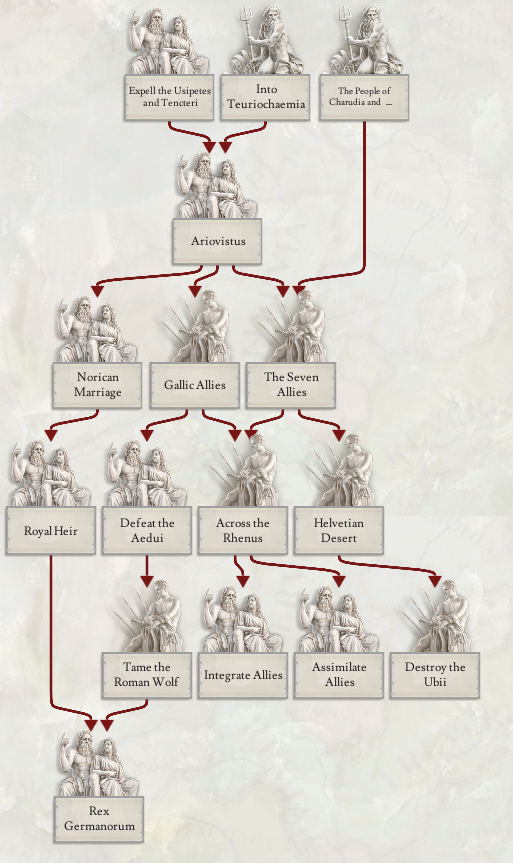
Finally, lovers of unique CoAs will surely enjoy @Torugu’s CoA for Langobardia, which is based on the Langobardian myth that they got their name (‘long beards’) from Odin himself.
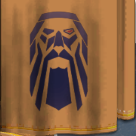
---- Complete Setup ------
Here is an overview of the new setup for the area around the Rhine and Suebia:
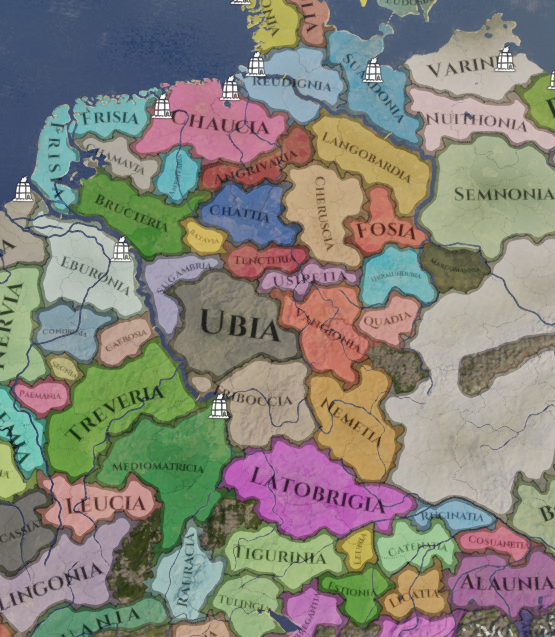
For reference the current setup:
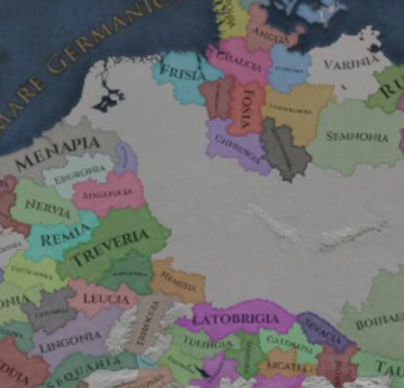
---- Teaser -----
This is all for today. Next week we will talk about something else, but I’ll leave you with a teaser for the second part of the Germania overhaul:

One mission tree to rule them all, one mission tree to find them,
One mission tree to bring them all and in Belgium bind them.
Today we’ll be talking about Germania!
An often requested feature for Invictus is to fill the area around the Rhine with playable tags and add more flavour to Germania. In this Dev Diary, we are going to present you this as well as flavour for these newly added Germanics and the Suebi.
Hello, I am Palando, the main developer for Germania. I am thankfully every now and then supported by @olivenkranz for the flavour texts. Apart from what I am going to present today, there is more content for other parts of Germania Magna planned but not yet ready to show.
------ Rhine-Weser Germanics ------
The primary focus of the Germania rework were the tribes east of the Rhenus (Rhine). Roman writers handed us down a remarkably detailed ‘setup’ for this area, together with some changes that happened during their control of the western side of the Rhine. Among these is the defeat of the Bructeri by the hands of the Chamavi and Angrivari, the migration of the Usipetes and Tencteri during Caesar’s Gallic War, the split of the Batavians and Chattians some unknown time before and the Chattians filling the void left by the Ubians after the latter’s resettlement across the Rhine. It was a goal to ‘reverse’ these movements to come close to the year 304 BC, but we cannot for sure know what happened in this prehistoric time, though archaeology points towards no major migrations for the period preceding the Roman conquest of Gaul.
Talking of which, the Rhine-Weser area was an extremely diverse one archaeologically. Some of the constants, together with the quite sparse written accounts, are going to make their way into the game via missions and events.
At first, there will be only one unique tree available with the primary path leading to the formation of the Frankish Kingdom. It asks you to unite your area, ‘civilise’ and fight a common enemy. The tasks are modeled around the historical formation of the Franks, albeit that happened later in opposition to the frontier of the Roman Empire. Because Rome’s rise is not certain, you can either wage war with the Romans or a Gaulish neighbour.
The optional branch is mostly based on the archaeological record and demands to build mines, trade with your neighbours, build a fortified trade post (based on the ‘Schnippenburg’) and then finally impose a standard for your iron bars, granting you a permanent bonus.
After forming Francia, another tree is unlocked and is based on the early expansion of the Franks. There are several economic and conquest related missions until the final row is reached. Completing the mission tree requires the player to choose which side of the Franks will dominate and set the focus of their country: either the Salians or, like in history, the Ripuarians.
------ Extremely Important Eburones -----
Across the Rhine, the cisrhenic Germanics were also looked upon. The biggest of those were the Eburones, which received the land they had according to Caesar and modern scholars. Additionally, four other smaller cisrhenic tribes were added: Paemania, Segnia, Caerosia and Condrusia.
Aduatucia was removed, as Caesar mentioned their creation by some Cimbric migrants during the migration of the Cimbri, Teutones and Ambrones. Also, Cugernia was removed, as they were created, when the Romans resettled a few Sugambrians.
We have plans to add more content to the Belgae, but they are not ready yet to be publicly shown.
------ Celts of Central Germany ------
Life was quite simple in ancient ethnography: west of the Rhine Celts with the exception of the cisrhenic Germanics and east of the Rhine only Germanic tribes. Archaeology paints here a somewhat different picture, as central and southern Germany was part of the La Tène culture, which is nowadays equaled to Celts by most scholars.
By the time the Romans reached the Rhine, most of the Celts of those areas had already moved to Gaul or were in the process to do so. Among these were the Helvetii, which left behind the so-called Helvetian desert in south-western Germany. But it appears that the Suebian leader Ariovistus also had Celtic allies in his federation, although Casar identified them all as Germanics. This can be deduced from the Celtic tribal names of the Nemetes and Tribocci, or the material culture and other names for the Vangiones, although the latter had a Germanic tribal name. The Suebi also threatened the Ubii, who can be identified as the inhabitants of one Celtic oppidum (= city) based on archaeology.
In sum, those four tribes were placed in the void between the Helvetii in the south and the Germanic north. Apart from the Ubii, however, there is some uncertainty as to from where the Vangiones, Nemetes and Tribocci originally came. The land those three own in the current setup was distributed between the Rauraci and Mediomatrici (note: these three inhabited Alsace only after Ariovistus crossed the river Rhine).
----- Suebi -----
As mentioned in the previous paragraphs, the Suebi started pushing westwards and crossed the Rhine. A welcome justification for Caesar to wage war against them. Although Caesar won, the Suebi still permanently filled the void left by the Celts that left central Germany and the Bohemian basin. The Marcomanni in Bohemia, the Quadi in Slovakia and Hermunduri in central Germany would threaten the Roman Empire in the 2nd century AD from those positions they already acquired in the second half of the 1st century BC.
The three aforementioned tribes were also added to the setup (respectively repositioned in the case of the Marcomanni):
Suardonia and Nuithonia are additions of Invictus’s release version.
Suebi nations also receive unique flavour like a decision to embellish their famous grave fields, the biggest of those was Mühlen-Eichsen close to the Baltic coast. Primarily, the mission trees are based on the settling of the Bohemian basin and the fight between Ariovistus and Caesar.
After forming Suebia or alternatively by starting as Marcomannia or Quadia, the player gets access to a mission tree to bring the Celtic reign in Boihaemia to an end. This new home has then to be settled and defended against foes from the south. An optional task is to enslave the Cotini living in the Slovakian mountains, as they were known to the Romans as tributaries that delivered gold to their Suebian overlords.
Historically, the timeline and events are not completely clear, but according to archaeology the intrusion of the Suebi into Bohemia started already when Caesar campaigned in Gaul. So unlike most of the interpretations of Roman sources, it appears that Maroboduus was not the conqueror and destroyer of the Boii.
The Cotini were also added as a two province minor in the Slovakian mountains. They start with access to gold, but it is up to the player how she or he will grow their domain; migrate, colonise or perhaps something else?
The second mission tree will be available again after forming Suebia or by starting as the mighty Semnonia. The mandatory path starts with expelling the Usipetes and Tencteri and conquering a pathway through the Thuringian forest. Thereafter, you unlock a mission to generate a character with the ‘Ariovistus’ cognomen, who can be made your new tribal chief aiding you in the completion of some further tasks. Then you have to bolster your ranks with ‘allies’ (though the word implies that they are equal, which is not the cause because of your Suebian superiority). Crossing the Rhenus and securing land for your people on the western side of it, will grant you access to a decision on how to deal with your ‘allies’.
Caesar described Ariovistus as ‘Rex Germanorum’, though this title was most likely not hereditary and not uncontested at that time. But what if Ariovistus had defeated the Romans and carved out a kingdom for himself? It is up to the player what will happen by going down this optional path. I took the liberty to interpret the name Ariovistus as a cognomen, as some scholars view it as a Celtic name.
Finally, lovers of unique CoAs will surely enjoy @Torugu’s CoA for Langobardia, which is based on the Langobardian myth that they got their name (‘long beards’) from Odin himself.
---- Complete Setup ------
Here is an overview of the new setup for the area around the Rhine and Suebia:
For reference the current setup:
---- Teaser -----
This is all for today. Next week we will talk about something else, but I’ll leave you with a teaser for the second part of the Germania overhaul:
One mission tree to rule them all, one mission tree to find them,
One mission tree to bring them all and in Belgium bind them.
- 34
- 10
What about Celtic presence in southern Poland? According to the archeologists there were at least 4 distinct Celtic groups as shown on this map of Celtic finds:
 celtyckapolska.pl
celtyckapolska.pl
They lived there since around 400 BCE to around 120 BCE. Here are two (probably early medieval) fortifications built on top of Celtic fortifications in Trepcza, near Sanok in SE Poland:

https://www.google.com/maps/place/49°35'06.0"N+22°11'05.0"E/@49.5955159,22.1932192,6285m/data=!3m1!1e3!4m5!3m4!1s0x0:0x0!8m2!3d49.585!4d22.184722
Gold stater of Alexander was found on the slope of one of them and is now presented in museum in Sanok. Also Celtic jewellery was found. Historians believe Celts migrated there because of salt present in that area (there is a range of hills literally called "Salty Mountains" there) and may be related to the Anarti mentioned by Ptolemy:

 en.wikipedia.org
en.wikipedia.org
CELTOWIE W POLSCE | Celtycka Polska
» CELTOWIE W POLSCE | celtowie w polsce i europie
They lived there since around 400 BCE to around 120 BCE. Here are two (probably early medieval) fortifications built on top of Celtic fortifications in Trepcza, near Sanok in SE Poland:

https://www.google.com/maps/place/49°35'06.0"N+22°11'05.0"E/@49.5955159,22.1932192,6285m/data=!3m1!1e3!4m5!3m4!1s0x0:0x0!8m2!3d49.585!4d22.184722
Gold stater of Alexander was found on the slope of one of them and is now presented in museum in Sanok. Also Celtic jewellery was found. Historians believe Celts migrated there because of salt present in that area (there is a range of hills literally called "Salty Mountains" there) and may be related to the Anarti mentioned by Ptolemy:

Anartes - Wikipedia
- 4
- 2
- 1
Great work! Personally I am always skeptical of user mods, I seem to have a certain OCD by which I want to play a vanilla game and trust only the developers. Now after reading through all the DDs I am convinced that Invictus is the only way that the game should be played. It reminds me of the Europa Barbarorum days of the first Rome Total War years. Congratulations!
Are there any plans to rework the Western Balkans, particularly the Adriatic hinterland? There the vanilla setup presents some obscure tribes such as Oxuaioia while completely ignoring certain major players at the time of the start of the game, e.g. Autariatae. It seems to me that in many cases roman historiography reporting on the political situation at the turn of the millennium (BC/AD) (the incursions into the area by Caesar and Augustus) and particularly the Pannonian Revolt were used instead of trying to present the political situation of previous centuries.
I recommend abilingual (Slovene/English) book "Appian and Illyricum" by one of the local experts (historian, archaeologist) Marjeta Šašel Kos. This book is a commentary to the short Illyrian History by the Greek historian from the 2nd century AD, Appian of Alexandria. Appian, though writing in the 2nd century AD, based his work on older Greek historiography of the area. Marjeta Šašel Kos compares Appian to other sources and presents a more complete history of the area going back to at least Alexander the Great. Her book also contains many useful maps. Unfortunately, I cant find a pdf currently. This is the official link: https://iza2.zrc-sazu.si/en/publikacije/appian-and-illyricum-1#v
EDIT: Actually the book is only in English
EDIT2: I found a scan of the book on Scribd, if anyone has access.
Are there any plans to rework the Western Balkans, particularly the Adriatic hinterland? There the vanilla setup presents some obscure tribes such as Oxuaioia while completely ignoring certain major players at the time of the start of the game, e.g. Autariatae. It seems to me that in many cases roman historiography reporting on the political situation at the turn of the millennium (BC/AD) (the incursions into the area by Caesar and Augustus) and particularly the Pannonian Revolt were used instead of trying to present the political situation of previous centuries.
I recommend a
EDIT: Actually the book is only in English
EDIT2: I found a scan of the book on Scribd, if anyone has access.
Last edited:
- 7
Have you thought to colaborate yourself with the mod as a scholar? Helping the devs build content for this region?Great work! Personally I am always skeptical of user mods, I seem to have a certain OCD by which I want to play a vanilla game and trust only the developers. Now after reading through all the DDs I am convinced that Invictus is the only way that the game should be played. It reminds me of the Europa Barbarorum days of the first Rome Total War years. Congratulations!
Are there any plans to rework the Western Balkans, particularly the Adriatic hinterland? There the vanilla setup presents some obscure tribes such as Oxuaioia while completely ignoring certain major players at the time of the start of the game, e.g. Autariatae. It seems to me that in many cases roman historiography reporting on the political situation at the turn of the millennium (BC/AD) (the incursions into the area by Caesar and Augustus) and particularly the Pannonian Revolt were used instead of trying to present the political situation of previous centuries.
I recommend abilingual (Slovene/English) book "Appian and Illyricum" by one of the local experts (historian, archaeologist) Marjeta Šašel Kos. This book is a commentary to the short Illyrian History by the Greek historian from the 2nd century AD, Appian of Alexandria. Appian, though writing in the 2nd century AD, based his work on older Greek historiography of the area. Marjeta Šašel Kos compares Appian to other sources and presents a more complete history of the area going back to at least Alexander the Great. Her book also contains many useful maps. Unfortunately, I cant find a pdf currently. This is the official link: https://iza2.zrc-sazu.si/en/publikacije/appian-and-illyricum-1#v
EDIT: Actually the book is only in English
EDIT2: I found a scan of the book on Scribd, if anyone has access.
- 4
From us all to you all, thank you! All your hard work is clearly showing and the mod both reads and plays amazingly! Great work, guys! Your creativity and dedication to historical sources are admirable. ^^
- 3
- 1
- 1
The archaeological papers I read point towards a minor migration of Celts in the late 4th century to Silesia and a much bigger wave a few decades later on. Most of the areas in your link belonged to the Boiian coinage system. The issues here are that we don't know any tribal names of the area, and if we lump them together under the name Boii, the tag would be quite huge and far stronger than anything around it.What about Celtic presence in southern Poland? According to the archeologists there were at least 4 distinct Celtic groups as shown on this map of Celtic finds:
CELTOWIE W POLSCE | Celtycka Polska
» CELTOWIE W POLSCE | celtowie w polsce i europieceltyckapolska.pl
They lived there since around 400 BCE to around 120 BCE. Here are two (probably early medieval) fortifications built on top of Celtic fortifications in Trepcza, near Sanok in SE Poland:
https://www.google.com/maps/place/49°35'06.0"N+22°11'05.0"E/@49.5955159,22.1932192,6285m/data=!3m1!1e3!4m5!3m4!1s0x0:0x0!8m2!3d49.585!4d22.184722
Gold stater of Alexander was found on the slope of one of them and is now presented in museum in Sanok. Also Celtic jewellery was found. Historians believe Celts migrated there because of salt present in that area (there is a range of hills literally called "Salty Mountains" there) and may be related to the Anarti mentioned by Ptolemy:

Anartes - Wikipedia
en.wikipedia.org

Thank you for the praise!Great work! Personally I am always skeptical of user mods, I seem to have a certain OCD by which I want to play a vanilla game and trust only the developers. Now after reading through all the DDs I am convinced that Invictus is the only way that the game should be played. It reminds me of the Europa Barbarorum days of the first Rome Total War years. Congratulations!
Are there any plans to rework the Western Balkans, particularly the Adriatic hinterland? There the vanilla setup presents some obscure tribes such as Oxuaioia while completely ignoring certain major players at the time of the start of the game, e.g. Autariatae. It seems to me that in many cases roman historiography reporting on the political situation at the turn of the millennium (BC/AD) (the incursions into the area by Caesar and Augustus) and particularly the Pannonian Revolt were used instead of trying to present the political situation of previous centuries.
I recommend abilingual (Slovene/English) book "Appian and Illyricum" by one of the local experts (historian, archaeologist) Marjeta Šašel Kos. This book is a commentary to the short Illyrian History by the Greek historian from the 2nd century AD, Appian of Alexandria. Appian, though writing in the 2nd century AD, based his work on older Greek historiography of the area. Marjeta Šašel Kos compares Appian to other sources and presents a more complete history of the area going back to at least Alexander the Great. Her book also contains many useful maps. Unfortunately, I cant find a pdf currently. This is the official link: https://iza2.zrc-sazu.si/en/publikacije/appian-and-illyricum-1#v
EDIT: Actually the book is only in English
EDIT2: I found a scan of the book on Scribd, if anyone has access.
Now regarding Illyria: I haven't read the book you mentioned so far, but I read "The Great Illyrian Revolt" and John Wilkes's "The Illyrians". The latter also has several maps that are quite different from the vanilla setup.
So I'd say that it's more a question of when than of if
- 3
Have you thought to colaborate yourself with the mod as a scholar? Helping the devs build content for this region?
he issues here are that we don't know any tribal names of the area, and if we lump them together under the name Boii, the tag wou
I have a feeling that the situation at the time of the Great Illyrian revolt is used as a setup in the vanilla. But the political situation at that time is not sufficient for 304 BC. I will try to find some time and study the book I mentioned further as well as some other sources and prepare a tentative setup. Perhaps the comparison of such a map with Wilkes and other sources can be usefull.
- 3
There are some tribes present that were 'created' by Roman resettlement programmes after the Great Illyrian Revolt. I think the setup mostly follows Ptolemaios's geography.I have a feeling that the situation at the time of the Great Illyrian revolt is used as a setup in the vanilla. But the political situation at that time is not sufficient for 304 BC. I will try to find some time and study the book I mentioned further as well as some other sources and prepare a tentative setup. Perhaps the comparison of such a map with Wilkes and other sources can be usefull.
- 1
Originally posted by Snowlet:
3. I've never seen this before, we'd need more info
The guy in the picture, a former slave, owns all the yellow holdings around Rome. He inherited them from two previous minor characters who were unrelated, and there may have been others before that. I have no idea how they got them. Let me know if you need more info.
.png)
3. I've never seen this before, we'd need more info
The guy in the picture, a former slave, owns all the yellow holdings around Rome. He inherited them from two previous minor characters who were unrelated, and there may have been others before that. I have no idea how they got them. Let me know if you need more info.
.png)
- 1
Weird to say the least, probably a hidden mechanic kicking in.Originally posted by Snowlet:
3. I've never seen this before, we'd need more info
The guy in the picture, a former slave, owns all the yellow holdings around Rome. He inherited them from two previous minor characters who were unrelated, and there may have been others before that. I have no idea how they got them. Let me know if you need more info.
View attachment 749763
Happened to me in vanilla, I think it was after the culture integration event, which is quite broken. It gives you an option to make a major family of the culture you integrate, the other option is to keep family which it supposed to replace, but.. just as the event fires it instantly removes the existing family, so even if you restore them into their position they have to adopt new members.The guy in the picture, a former slave, owns all the yellow holdings around Rome. He inherited them from two previous minor characters who were unrelated, and there may have been others before that. I have no idea how they got them. Let me know if you need more info.
EDIT. Forgot to mention, that those characters that got their family "membership" revoked still keep their holdings.
Last edited:
I've just discovered the mod through steam and I'm starting to read the DDs. This looks good ! Thank you so much for not having given up on the game !
- 4
The same is true for me. Thanks for keeping a great game alive and making it even better!
- 2
Threadmarks
View all 88 threadmarks
Reader mode
Reader mode

